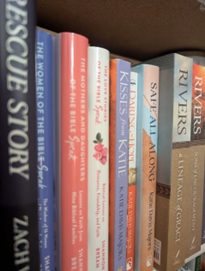Every school break, no matter how long, I’m always looking forward to spending more time deep in a book. This summer was no different. As I do every several months, I provide you, my audience, with some of my favorite picks from my own reading list. Without further ado, here are my favorite reads of the summer of 2024:
“The Atonement Child” by Francine Rivers
Rivers’ is a Christian author whose books grapple with difficult modern issues such as abortion, euthanasia, infidelity, single parenthood and so much more. These issues and the perspective the author takes are still relevant today.
“The Atonement Child” tells the story of Dynah Carey, a student at a Christian college in Illinois. Engaged to a pastor-in-training with a job she loves, everything is looking up in her life, but Dynah’s whole world is shattered in one night after being raped and becoming pregnant.
As Dynah grapples with her own trauma, she faces pressure from her fiancé, her best friend and the college to pursue an abortion. Dynah ultimately drops out of school and flees home to California, only to find pressure from her parents to make the same decision that her college, despite being Christian, told her to make.
Unbeknownst to Dynah, her own family was scarred by abortion in the past, leaving her feeling even more betrayed and pulled on from all sides.
The book doesn’t take on the problem of abortion in the typical fashion: the focus isn’t on the pregnancy nor the baby. Its focus is on the mothers who choose abortion, the effect it has on their lives and the trauma of their different situations.
Author Francine Rivers wrote “The Atonement Child” as a way of telling her own abortion story, giving a voice to the mothers who have ever been faced with this life-altering situation.
I love that the author can use her personal experiences to bring this story to life. The book delivers a message that the world needs to hear: what happens to the mothers a few hours, a few days, a few decades after an abortion?
“The Women Who Lived for Danger” by Marcus Binney
World War II was one of the most climactic events in recent history, and while the soldiers on the front lines bore the brunt of the fighting, there were those behind the scenes who also risked their lives for what they believed in.
Author Marcus Binney compiled a series of minibiographies of ten women of the Allied underground who volunteered to work as secret agents behind enemy lines during the war. Binney takes the time to detail each of the ten profound women from their birth, through the war and what happened once the war ended–whether they survived or not.
“The Gallagher Girls” series by Ally Carter
I’m counting a whole series as one book because all six would fill my entire reading list.
Cammie Morgan is a normal teenage girl in just about every sense, except that she and her best friends attend a school for spies. They get extra credit for helping their teachers create self-destructing paper, their school teaches fourteen different languages and covert operations practice can involve impromptu helicopter rides.
Throughout the series, we follow Cammie and her three best friends as they learn to navigate the real world outside the safety of the Gallagher Academy for Exceptional Young Women and get caught up in an ancient organization that is bent on destruction in many different forms.
“Close Up on War” by Mary Cronk Farrell
Catherine Leroy (pronounced LEE-rah) was born in Paris, France in 1944. She attended a Catholic boarding school and, on a whim, earned her parachutist’s license at the age of eighteen. Armed with that certification and her passion for photography, after seeing pictures of the Vietnam War in a French news magazine, she bought a one-way ticket to Saigon at age twenty-one. She became the only non-military photographer and the only woman to drop into the heart of the Vietnam War. Leroy survived capture, being wounded, disease and the pressure of selling her own work to news publications around the world while being one of the youngest and only women in the war.
Farrell tells the fascinating story of this tiny, headstrong French girl, complete with many of Leroy’s own pictures. This book had a great timeline to follow for the war and had the bonus of providing a real-life perspective of the front lines.
“The Magician’s Nephew” by C.S. Lewis
The first book in The Chronicles of Narnia series sets the stage for the following six novels, and the author does an excellent job explaining the premise of this fantasy world.
Young Digory Kirke and his mother had just moved in with his elderly aunt and uncle at the book’s premise. Feeling lonely, Digory befriends his new neighbor, Polly Plummer, and convinces her to explore the passage between the walls of their row house together. The pair accidentally stumble into Digory’s Uncle Andrew’s secret laboratory, where he has been experimenting with travel to worlds in other dimensions.
Digory and Polly are tricked into experimenting with his discoveries and find themselves in a tangle between the worlds, both their own and the ones they discover. In the process, they witness the creation of the new world of Narnia by the Great Lion, Aslan, and the first prophecy of what is to come in the following books.
C.S. Lewis wrote the series as children’s books, but even so, I find myself enjoying them as a college student. I haven’t read “The Magician’s Nephew” since middle school, and it’s still just as good.
Books are a bridge to new ideas and new thoughts and give insight into a way of life that many of us have never seen or thought about. Whether it be an old favorite or a new read that catches your eye, picking up a good book is always beneficial.
